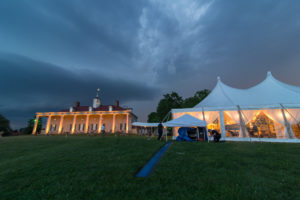MeetingMentor Magazine
What to Do in a Weather Emergency
By AJ Bownas
You have built a high-end, exclusive and private experience that is unique — even though the client and guests have visited the destination several times previously. Your team can’t wait to provide this truly original, nearly impossible-to-replicate event.
But what do you do when a major weather event threatens the safety and the very structure of the event itself?
Stay Tuned! For more on how to keep your meetings safe and secure, look for a special feature in the Spring 2019 issue of MeetingMentor.
From Lightning to Light Show
 The stage was set for a special closing night at an event held in Washington, D.C., in May. We knew the weather could be humid and unpredictable, so we had a carefully laid risk management plan — which we hoped not to have to put into action.
The stage was set for a special closing night at an event held in Washington, D.C., in May. We knew the weather could be humid and unpredictable, so we had a carefully laid risk management plan — which we hoped not to have to put into action.
All went as planned as the guests were ushered onto a private yacht, which sailed up the Potomac River to the home of the first presidential family at Mt. Vernon. As guests disembarked, a traditional fife-and-drum corps performed a welcome salute while they boarded private motor coaches that swept them up the hill to the mansion’s front portico. Greeting the guests personally was George Washington himself (or a reasonable facsimile thereof), who invited them to join him and his wife, Martha, for cocktails before they descended across the lawn to a customized tent structure decorated to look more like a free-standing room for dinner service than a tent. Hidden from the guests’ view was the other half of this tent, where they would experience a radically different décor during a post-dinner concert.
It was during dinner that the on-site destination management company (DMC) staff noticed a severe shift on their weather-monitoring apps, with reports of an intense lightning storm making its way swiftly toward their location.
Because of the tent’s metal framing, guests would need to be evacuated to a safe location until the weather cleared. The issue was communicated to the client, and venue staff in period costumes, holding candlelit lanterns, lined the walkways to the interior space, while DMC staff with golf umbrellas escorted groups of guests, shielding them from the falling rain. The caterer was able to shift to coordinate the postdinner wine service inside the building, while guests had a chance to mingle with some of the evening’s entertainment. After the storm — a 45-minute light show that dazzled many of the Californian guests — had passed, they were ushered back into the concert tent for the evening’s performance, which continued as originally planned.
How to Prepare for Anything
Looking back on this event, the planning experiences as the evening played out were invaluable and continue to inform our efforts for other clients. Here are some of our takeaways:
• Don’t just create a risk management plan; rehearse it. Given the nature of the event experience and the intimate venue, there were 10 different vendor teams working inside the same tent. There also were sizable generators powering climate control, the lighting and AV systems, and the catering kitchen. This meant a significant number of bodies moving in and around the space, which had to be coordinated well in advance to ensure a seamless flow.
Takeaway: As much as possible, rehearse the movements and paths in and around the event space with your vendors, especially for events taking place outdoors. Walk the routes, and answer questions in advance of guest arrival to ensure that everyone understands the plan and their place in it should a situation arise.
• Always watch the weather from multiple sources. Every event professional knows that Mother Nature is not always our friend. But all weather apps are not necessarily created equal, and even a slight delay in receiving real-time information due to app issues or Wi-Fi/cellular connection can place you at a disadvantage.
Takeaway: Ask that multiple members of your on-site team have weather monitoring apps on their phones and that they check them regularly in the days leading up to the event as well as on the day it occurs. If at all possible, coordinate with the in-house venue team for further intel, as they may have their own reporting and monitoring systems in place.
• Keep the client informed of changes, but be discreet. What we and our clients want is to be part of an incredible event. Ideally, the client will be able to relax and enjoy the day, leaving the logistics in the hands of the DMC partner. But in a scenario like this, it’s essential to make sure that the client is kept informed and feels part of the solution, while still not disturbing the guests.
Takeaway: Because we relayed the risk and the solutions in place in this situation, the client was able to help guests remain calm and happy and even helped add a sense of anticipation and excitement to the overall situation. The only casualties of the evening were three large rugs, repurposed to ensure that guests could walk from path to path without getting muddy.
• Build guest experience into your risk management plan. The first priority in a situation like this has to be safety — of the client and guests, of the support team and vendors, and of the venue/event space itself. However, the guest experience is still happening as you work to satisfy these conditions.
Takeaway: By working with the catering team to continue the wine service and by incorporating costumed venue staff, guests remained engaged and entertained, without their overall experience being disrupted. Some guests even took advantage of the incredible vantage point to watch the storm play out from the safety of the designated shelter, turning a potential disaster into an unexpected enhancement!
• Stay in constant communication with your on-site vendors. In the event of any emergency, every member of the on-site team, regardless of whom they are working for, needs to be quickly and comprehensively briefed on the situation and the resolutions. You must be ready to activate a multifaceted plan to secure guests and equipment, shut down power in sensitive areas, and provide services to guests that augment rather than detract from their overall experience.
Takeaway: Move calmly but speedily, and maintain continual contact as the situation develops. Circle back to vendors to ensure compliance with the plan and offer assistance wherever possible.
 AJ Bownas is the general manager of CSI DMC’s regional office in Washington, D.C. (CSI Washington, DC): CSI DMC is an award-winning national destination management company. Contact Bownas at aj@csi-dc.com.
AJ Bownas is the general manager of CSI DMC’s regional office in Washington, D.C. (CSI Washington, DC): CSI DMC is an award-winning national destination management company. Contact Bownas at aj@csi-dc.com.
Free Subscription to
MeetingMentor Online
"*" indicates required fields
About ConferenceDirect
About MeetingMentor